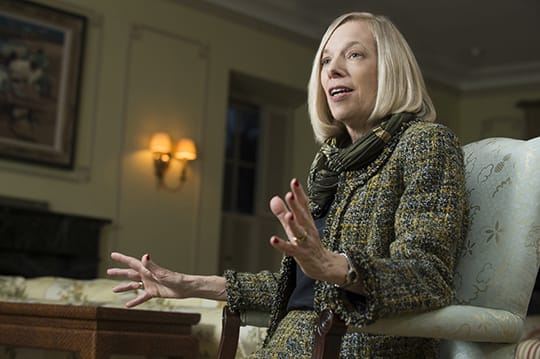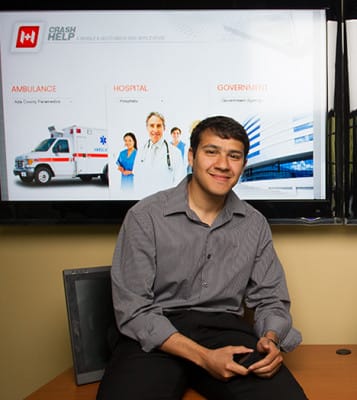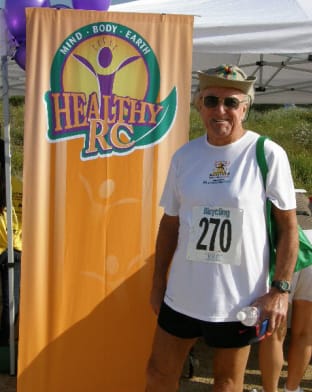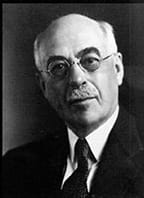Applied Research: A Conversation With President Freund

When Dr. James A. Blaisdell created the graduate school that would bring his vision of a world-renowned educational institution dedicated to improving peoples’ lives through research and teaching, few could have predicted the enormous changes to come: another world war, the rise of America as a superpower, landing on the moon, and the birth of the information age. New academic fields such as business management and information technology rose to prominence, and the World Wide Web and smartphones have redefined the definition of the classroom.
What has sustained CGU as a world-renowned university and provided us with our core strength throughout these changing decades is our leadership in, and continued commitment to applied research and teaching. What we discover and teach can solve problems from half-a-world away or right in our backyard. And, with our location in Southern California, faculty and students are in one of the most extraordinary laboratories possible for diversity, innovation, and global connections.
In this Q&A, President Deborah Freund describes why applied research and teaching continue to matter in the university’s plan, and what is taking place today that will strengthen CGU’s future.
WHY IS APPLIED RESEARCH AND TEACHING SO IMPORTANT?
The opening to our mission statement, “The mission of Claremont Graduate University is to prepare a diverse group of outstanding individuals to assume leadership roles in the worldwide community…,” says it all.
Problems today are not theoretical. They are real and almost always have elements that span across the traditional academic fields. We know that what happens in distant time zones affects us right here in Southern California. And, what we learn from our practice-based research informs not only what we teach, it has a positive impact on lives in our communities and across the globe. This evolving connected space of global and local, and applied research and teaching is right where we “live.” It is in our DNA, and it has to direct our future if we are to fulfill our mission of creating leaders who can address these complex challenges.

I’m thinking, for example, of a student in our Center for Information Systems & Technology (CISAT). His name is Abdullah Murad. He came to us from Saudi Arabia. As part of his PhD studies, he was part of a research project focused on the common communication breakdowns in the United States between paramedics responding to a medical emergency and emergency room professionals. This is not strictly a problem for our country.
Working with CISAT Clinical Assistant Professor Brian Hilton and other students, Murad helped to develop CrashHelp. This prototype is being developed to address the communication problems between first responders and medical professionals. The need exists to capture essential patient information and transmit that data to trauma center practitioners while paramedics and patients are in route. The team worked to develop the prototype and then engaged in hands-on testing of it in Idaho. That was applied research at its best, watching paramedics and physicians using your work to save lives. Now, when Murad graduates and goes home, he will be taking a position with the GIS Technology Innovation Center at Umm Al-Qura University in Mecca, Saudi Arabia. There he will continue to apply the leadership skills he learned at CGU to inspire others and benefit his country.
IS THIS A CONSISTENT COMMITMENT IN ALL THE SCHOOLS AT CGU?
Of course. Applied research and teaching have been a foundational strength for our schools since our inception, and it is only getting stronger thanks to the leadership of our deans and faculty. Let me give you some examples of our most recent planning and activity.
Dean Larry Crosby, from our Peter F. Drucker & Masatoshi Ito Graduate School of Management, is investigating the challenges facing managers in the supply chain industry. The Ports of Los Angeles and Long Beach, two of the biggest ports of entry for goods imported in the United States, are less than 50 miles from campus. Additionally, one of the largest collections of distribution centers anywhere is only 10 miles from campus. The companies involved are global leaders: Amazon, FedEx, and UPS, for example.
The Drucker School is working with supply chain industry partners who want solutions to the challenges coming at them from all over the world. We have already identified ways we can design custom research, develop case studies, customize curriculum, create certificate programs, and convene leadership summits on supply chain issues.
Some of the concerns are also quality-of-life issues for the local community. That’s why the Drucker School is working with public and private organizations focused on the regional issues of environmental quality, job growth, and traffic congestion. (Editor’s note: see page 20 for a more detailed story in this issue describing the supply chain industry and the Drucker School’s involvement in this critical part of our economy.)
The Institute of Mathematical Sciences (IMS) has a decades-long history of applied research going back to the 1970s, including such partners as Lockheed, Chevron, McDonnell Douglas, and Boeing as well as the Jet Propulsion Laboratory, the U.S. Forest Service, and the U.S. Department of Energy.
IMS faculty and students have been collaborating with industry and governmental partnerships with Southern California Edison and the Los Alamos National Laboratory in New Mexico. Working with Los Alamos, student-led teams developed “smart grid” strategies that allow providers of renewable energy to deliver electricity to users in a cost-effective, efficient, and reliable manner. On a more local level, students have been assisting Southern California Edison with replacing its aging transformers and infrastructure by formulating mathematical models to predict failure rates and maximize equipment reliability. Edison serves nearly 14 million people in 15 counties. This truly illustrates what Institute Director Allon Percus says: “Mathematics affects people’s lives.”
In the School of Arts & Humanities’ Museum Studies program, students working with Associate Professor of Cultural Studies and History Joshua Goode are also taught courses by museum directors and curators. The courses they are taking marry theory with practice; it’s real practiced-based education. Their partnerships include the Wende Museum in Culver City and the Autry National Center of the American West in Los Angeles. Students are working with the museum’s actual collections to build physical and virtual exhibitions, to develop online content for museums. In efforts to mimic the actual curatorial process, the students have the opportunity to pitch their ideas directly to Autry staff, Goode said.
Another example is the School of Educational Studies (SES). Beyond the hundreds of college and university presidents and faculty, plus the K-12 superintendents, principals, and faculty who are alumni of SES, the school is actively engaged in tackling many of Southern California’s urgent problems with its successful Urban Leadership program, its Community College Professional Leadership Certificate, and Teacher Education’s STEM (science, technology, engineering, and math) student recruitment and training program. Now, the school is working on a new Education Evaluation Internship with the Alliance for Education in San Bernardino County. It’s a competitive program that provides students with hands-on experience using county, district, school, and student-level data. So, the students have the invaluable experience, and they are also providing an important service by assessing the county’s progress in improving college success, career readiness, and STEM education.
The School of Community and Global Health (SCGH) has an outstanding global reputation for the work it has done in China, especially on health policy issues surrounding smoking, which is a great concern in that country. Bringing that expertise back to address local concerns, SCGH is collaborating with Riverside County, Inland Empire Health Plan, and the University of California, Riverside, in an overall effort to establish a Community Translational Research Institute to promote public health for our local communities. The goal is to bring their global expertise to “translate” prevention science research into public policy and practice. Teams of SCGH students have embarked on a three-year pilot project providing assessments of diabetes screenings and obesity prevention programs, which also provides them with practice-based learning and will have a significant impact on the lives of residents in local communities.

All of this is in addition to CGU student participation in the Randall Lewis Health Policy Fellowships. Through these fellowships, our students tackle a wide variety of pressing healthcare issues throughout Southern California. Currently, these fellows are working with Rancho Cucamonga city officials to promote exercise, healthy eating, and lifelong learning as part of that city’s “Healthy RC” program.
In the School of Social Science, Policy & Evaluation (SSSPE) faculty and students are providing critical support through the school’s Claremont Evaluation Center for the Riverside County Department of Mental Health and San Bernardino County’s Patton State Hospital in measuring the effectiveness of the agencies’ programs. They’ve completed similar projects with the United Way, Habitat for Humanity, the YMCA, and the Blood Bank of San Bernardino. SSSPE faculty and students also are working with Five Acres in Altadena and Hathaway-Sycamores in Pasadena. These two organizations provide an array of services to Southern California children and families, including mental health support, foster care, and adoption services.
A final example I’ll give is a university-wide opportunity for CGU students: the new Randall Lewis Community Internship Program, made possible by a grant from Lewis Operating Companies. It’s a competitive program that involves a semester-long internship where the selected students from our five schools can both learn from their practice in a local organization and, at the same time, use their CGU education to benefit the organization’s goals. Once again, it’s that practice-based research and education win-win. Today, Randall Lewis students are working on a marketing project for the City of Rialto and a project for the Upland Unified School District that will compare student performance outcomes in the district. This enlightened program will have a broad and positive impact throughout Southern California, especially in underserved areas.

DO YOU THINK JAMES BLAISDELL WOULD RECOGNIZE CGU TODAY?
Yes, I do. As long as we keep our focus on our mission of training leaders who want to and can make a positive difference from what they learn while at CGU, then we will continue to achieve that balance between theoretical and applied, between global impact and local involvement that we have maintained for the past 89 years. What we learn is what we teach, and what we teach changes the world.
I think James Blaisdell would be surprised at everything we are involved in across the globe and here at home, and where our graduates are in the world, the good they are doing. However, I have no doubt that he would recognize that fundamental core of applied research and education to improve peoples’ lives that he first envisioned, and I know he would be proud.